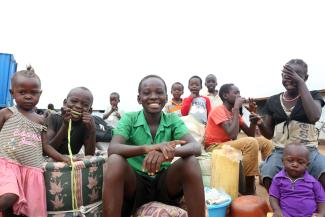The United States is the largest single donor of humanitarian assistance in Uganda, supporting emergency food and nutrition assistance, medical care, water, prevention of and response to gender-based violence, and livelihoods support to refugees and their surrounding communities.
REFUGEES
Since gaining independence in 1962, Uganda has provided asylum to people fleeing war and persecution in neighboring countries, especially Burundi, the Democratic Republic of the Congo, Eritrea, Rwanda, Somalia, and South Sudan. Today Uganda hosts over a million refugees spread across 13 settlements. Although the Government of Uganda provides refugees are provided small plots of land for farming, many of these households remain reliant on humanitarian assistance to eat. USAID partners with the World Food Program to distribute locally- and regionally-procured emergency food assistance; enabling rapidly food assistance delivery to populations in need while simultaneously strengthening regional economies.
KARAMOJA
After decades of conflict in Karamoja, communities have transitioned from nomadic herding to raising animals in stationary kraals—fenced enclosures for cattle and other livestock—and crop farming as primary livelihoods. This shift makes farmers more dependent on the increasingly erratic climate in northern Uganda, which has just one annual rainy season from April to October. Concentrated grazing, broad dependence on rain-fed agriculture, and suboptimal farming practices aggravate food needs during the March-to-July lean season—the period of the year when food is most scarce.
PROMOTING RESILIENCE
USAID strengthens the resilience of vulnerable Ugandan households and communities to mitigate and recover from shocks and stresses. Failed harvests from variable rainfall, health shocks, chronic malnutrition and lack of education contribute to poverty, which affects 70 percent of all Ugandans. USAID’s efforts to decrease vulnerability range from providing direct emergency food assistance to implementing nutrition and livelihood development activities and connecting isolated communities to improved health and market systems. Through integrated resilience programming in economic growth activities, USAID is facilitating inclusive growth while sustainably reducing poverty

Anne Ackermann/USAID
